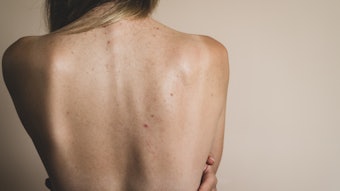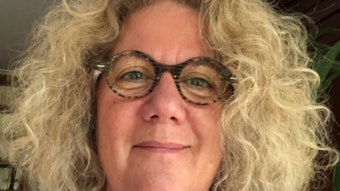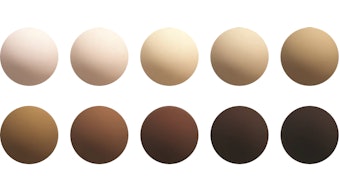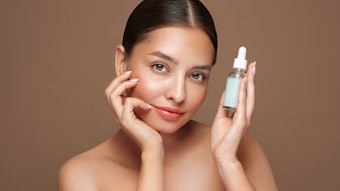
Herbal extracts for skin firming: Sommerfeld reports1 on the clinical efficacy of a blendaof herbal extracts—including Rosmarinus officinalis (rosemary), Centella asiatica (gotu kola), Curcuma longa (turmeric) and dimethylaminoethanol (DMAE)—to promote skin firmness. The blend was tested for firming and elasticity benefits in photo-aged facial skin via a randomized, placebo-controlled, double-blind, split-face study in 28 women aged 34–67 years. Treatments were administered with the tested blend and a placebo for four weeks. Skin firmness and elasticity were evaluated using the speed of propagation of ultrasound shear waves in the skin as end point. The study was completed by 25 women.
Log in to view the full article
Skin and Skin Care
Herbal extracts for skin firming: Sommerfeld reports1 on the clinical efficacy of a blendaof herbal extracts—including Rosmarinus officinalis (rosemary), Centella asiatica (gotu kola), Curcuma longa (turmeric) and dimethylaminoethanol (DMAE)—to promote skin firmness. The blend was tested for firming and elasticity benefits in photo-aged facial skin via a randomized, placebo-controlled, double-blind, split-face study in 28 women aged 34–67 years. Treatments were administered with the tested blend and a placebo for four weeks. Skin firmness and elasticity were evaluated using the speed of propagation of ultrasound shear waves in the skin as end point. The study was completed by 25 women.
No immediate effect was observed with the tested herbal extract blend; however, the four-week treatment resulted in a significantly reduced propagation speed, indicating increased skin firmness. A self evaluation was conducted by the test subjects to determine observable treatment effects and the herbal extract blend was rated significantly higher than the placebo. The clinical evaluation also showed the blend to provide better treatment results than the placebo.
Tolerance to the herbal extract blend was generally good. However, three women experiencing mild irritant contact dermatitis did not complete the study. Overall, the results showed that the herbal extract blend increaseed skin firmness both objectively and subjectively. Further studies are warranted.
Ziyuglycoside I for antiwrinkle: Kim et al. report on the antiwrinkle activity of ziyuglycoside I, isolated from a Sanguisorba officinalis root extract, and its application as a cosmeceutical ingredient.2 In order to investigate the potential of a S. officinalis root extract as an antiwrinkle active, the researchers measured its free radical scavenging activity, elastase inhibitory activity, the expression of MMP-1 (matrix metalloprotease-1) in vitro, and the synthesis of type I collagen in normal human fibroblast cells. To isolate the main components from the S. officinalis root extract, the extract was purified by solvent fractionation, column chromatography and recrystallization. The active component was identified as ziyuglycoside I by a spectroscopic analysis.
Ziyuglycoside I was found to increase the expression of type I collagen in a dose-dependent manner, by up to 71.3% at 50 μm. A clinical study using visual evaluation and image analysis tested a formulation containing ziyuglycoside I, revealing the test formula to have a significantly greater effect (p< 0.05) than the placebo. This result suggests that ziyuglycoside I isolated from S. officinalis could be used as an active ingredient for cosmetics.
Skin peeling: L’Oréal discloses a skin-peeling composition containing a glycosaminoglycan.3 A topical composition is described comprising at least a glycosaminoglycan and 1% w/w of a peeling agent. This composition is intended for peeling the surface of skin and attenuation of the visible and/or tactile irregularities of the skin such as wrinkles, uneven color and marks of acne or chicken pox; and/or removing obstructions from the pores of the skin. An example is shown in Formula 1.
Stable ceramide dispersions: Kao Corp. discloses stable ceramide dispersions, their manufacture and cosmetics containing them.4 Their manufacture is described by dispersing mixtures containing ceramides, N-acyl-N-alkyltaurines (salts) and glycerin at a ceramide to salt ratio of 2:1–14:1, and glycerin content of 70–99% w/w in water. An example is shown in Formula 2.
Hair and Hair Care
Hair growth, lipid synthesis: Vingler et al. report that 6-O glucose linoleate supports in vitro human hair growth and lipid synthesis.5 According to the study, hair follicles are active organs with complex structures that produce hair fibers at a rate of 0.3 mm/day. Accordingly, the hair follicle is highly demanding of energy since the hair bulb matrix cells are endowed with one of the highest rates of proliferation in the human body. Moreover, recent data has shown the involvement of lipids in hair follicle function.
In vitro-grown hair follicles produce hair fibers that closely resemble natural hair fiber, thus the authors used this model to investigate the role of 6-O-linoleyl-d-glucose (6-O-GL) as a lipid precursor and an energy provider. Their results demonstrated that 6-O-GL was stable and surprisingly resistant to oxidative degradation. In addition, 6-O-GL was reported as “readily” taken up and metabolized by the hair follicle into various lipids, namely neutral lipids, ceramides and polar lipids. Moreover, it supported hair follicle growth and survival in a glucose- and linoleic-acid free medium. 6-O-GL thus appears to be a bifunctional nutrient, ensuring proper fiber quality and production by the hair follicle.
Pulverized hair conditioner: Wella discloses a “pulverized” hair care treatment containing surfactants, polymers and silicones.6 The described invention relates to hair products comprising fluid conditioning compositions that are absorbed onto a solid carrier, wherein the fluid composition contains at least one hair care agent selected from: hair conditioning surfactants, polymers or silicones; fatty alcohols, oils, panthenol, amino acids, panthenyl ethyl ether, sorbitol, betaine, creatine and protein hydrolyzates. The described carrier is a nonwaxy material that is solid at room temperature.
The products can be made by first dissolving a gas at high pressure into the fluid hair conditioning composition and then expanding the liquid/gas solution, wherein the solid carrier is added before, during or shortly after said expansion. The resulting products can be used to condition hair, an example of which is shown in Formula 3.
Hair fixative on a waxy carrier: Wella also discloses a nonfluid hair treatment product comprising a hair fixative absorbed on a waxy carrier.7 The product can be made by pulverizing a fluid hair styling composition onto a nonfluid waxy carrier, especially by first dissolving a gas at high pressure into a fluid hair styling composition then expanding the liquid/gas solution. Within this composition, the solid waxy carrier is added in a solid form before, during or shortly after the expansion. This waxy material can be in the form of snow-like flakes that are easily melted and can easily be distributed onto hair. The composition of a fluid styling gel is shown in Formula 4.
Quaternary ammonium polymers: L’Oréal S.A. discloses compositions containing quaternary ammonium polymers and their preparation and use.8 The described compositions contain at least one alcohol-insoluble quaternary ammonium polymer, at least one amphoteric surfactant, at least one nonionic surfactant and, optionally, at least one phospholipid compound. An example is shown in Formula 5.
Bleached hair treatment: Henkel has been granted a patent for agents that remove green tint from bleached and blond hair.9 These agents exhibit a pH level between 2 and 5, preferably in the 3–4 range, and contain complexing agents selected from the group of esters including: citric and salicylic acids, aminopolycarboxylic acids, phosphonates and phosphates, gluconates, and nitroacetic acid and its salts. Cationic polymers, fatty alcohols, sulfates, amphoteric surfactants, vitamins, amino acids and direct dyes also can be included in the formulation. The compositions are used as pre- or post-treatment agents in combination with hair bleaching and or dyeing.
Transparent gel shampoos: Lion Corp. has been granted a patent on low-viscosity transparent gel shampoos containing specific surfactants, cationized polymers containing a sugar moiety, and inorganic salts.10 The described shampoos have a viscosity at 25°C between 10–100 Pa-s and can be smoothly discharged from tubular containers. These formulations contain polyoxyalkylene alkyl ether sulfate salts, betaine-type amphoteric surfactants, cationized polymers having a sugar moiety, inorganic salts and polyglycerin fatty acid esters (HLB >12). An example is shown in Formula 6.
Microporous hair treatment: The Procter & Gamble Company discloses a hair treatment application system comprising a microporous absorbent substrate.11 This system includes one or more hair compositions having a viscosity between 3,000 cPs and 150,000 cPs, and a hair treatment application device consisting of two plates positionable in a juxtaposed relationship when the device is in a closed state. The device is characterized by a first zone with at least one absorbent substrate on the internal surface of the first plate, and a second zone on the internal surface that is free of the absorbent substrate. At least one of the absorbent substrates has a median pore radius between 300 μ to 3,000 μ. The present invention also describes methods of treating hair with the aforementioned formula. An example of a hair styling composition used with this apparatus is shown in Formula 7.
Anti-frizz composition: An aqueous anti-frizz composition is described in a patent assigned to L’Oréal.12 The described invention also includes a process to inhibit hair from becoming frizzy when it is exposed to high and/or low humidity. The composition contains: a) at least one nitrogen-containing compound, chosen from polyamine compounds having at least three amino groups, fatty monoamine compounds, fatty quaternary amine compounds, phospholipids and mixtures thereof;
b) at least one nonionic surfactant; c) at least one anionic silicone; d) at least one water-insoluble material chosen from non-anionic silicones, hydrocarbon oils, plant oils, fatty acids, fatty esters, fatty alcohols, fatty waxes and mixtures thereof; e) at least one cationic polymer; and optionally, f) at least one film-forming polymer that is different from the cationic polymer in e). An example of a shampoo formulation based on this system is shown in Formula 8.
Soft, smooth hair rinse: Kao Corp. discloses hair cosmetic compositions containing tertiary amine-based surfactants, nitrogen-containing organic acid and higher alcohols.13 The invention relates to a hair rinse that provides softness and smoothness to hair. The described composition contains: a) a tertiary amine-based cationic surfactant; b) an organic acid represented by the general formula:
R1N(R2COOH)R3COOH
where R1 = C1-5 alkyl, hydroxyalkyl, R4COOH and R2, R3, R4 = C1-5 alkylene; and c) a C8-30 higher alcohol.
The composition may further contain a branched fatty acid represented by the general formula:
MeCH(R5)(CH2)nCOOH
where R5 = Me, Et; and n = 3-36. An example of a hair conditioner based on this system is shown in Formula 9.
Hair waving: Takara Belmont Co., Ltd., discloses permanent hair wave-setting agents containing mercaptans and polyhydric alcohols, and a method to set permanent hair waves.14 The permanent wave-setting agent consists of a first and second agent, wherein the first agent contains a 1–9% mercaptan and a polyhydric alcohol with a boiling point >200°C. This agent enables the formation of long-lasting hair waves without the loosening of curls after drying. Preferably, the first agent further contains a hydrogen bond open-chain-promoting component. An example is shown in Formula 10.
Transparent gel hair conditioner: Ajinomoto Co., Inc., discloses transparent gel compositions containing N-long-chain acyl amino acids and cationic surfactants.15 The described invention provides excellent hair-conditioning effects. The composition contains N-long-chain acyl amino acid and/or its salt, a cationic surfactant and water. An example of a transparent gel hair conditioner is shown in Formula 11.
Hair styling conditioners: Lion Corp. discloses hair styling conditioners including amino-modified silicones, polyoxyalkylenes and cationic surfactants.16 The hair styling conditioners contain cationic surfactants and high melting point amino-modified silicones such as:
Me3SiO(SiMe2O)m
[SiMe[(CH2)3NH2]O]nSiMe3
where m and n = integer; and the moieties m + n are in the range of 3,000–20,000;
R1O(C2H4O)p(C3H6O)qR2
where R1, R2 = alkyl, glyceryl, H; and p, q >30; and
R1O(C2H4O)p(C3H6O)qR2
where R1, R2 = alkyl, glyceryl, H; and p, q = 1–29. An example of such a hair gel is shown in Formula 12.
Milder oxidative hair treatment: Henkel KgaA has been granted a patent on an oxidative hair treatment and a process that causes less damage to hair.17 Superoxide dismutase can be used in an oxidative hair treatment to decrease hair damage and scalp discomfort. For example, directly before applying an oxidative cosmetic medium, inventors applied a medium of superoxide dismutase in a cosmetic carrier and rinsed it off after an induction period.
Interesting New Raw Materials
New saccharide esters: Tiense Suikerrafinaderij N.V. discloses a new class of saccharide esters as surfactants for cosmetics.18 These materials include esters of: polyhydroxyalkanoic acids and polyhydroxyalkenoic acids; saccharide esters of hydroxy-, alkanoyloxy- and polyhydroxyalkanoyloxy-substituted alkyl carbamic acids; and saccharide esters of hydroxyalkenoyl-, oxy- and polyhydroxyalkenoyloxy-substituted alkenyl carbamic acids.
Also discussed is their preparation as well as the use of the esters as surfactants—typically as emulsifier/emulsion stabilizers and as dispersant/suspension stabilizers in emulsions and suspensions.
According to the inventors, the preferred esters are composed of a saccharide moiety derived from inulin or dextrin, and a polyhydroxyalkanoyl moiety derived from a poly(12-hydroxystearic acid) (PHS-acid). The saccharide esters are suitable for the preparation of stable emulsions, preferably in the presence of small amounts of an electrolyte.
References
1. B Sommerfeld, Randomized, placebo-controlled, double-blind, split-face study on the clinical efficacy of Tricutan on skin firmness, Phytomedicine, 14(11) 711–715 (2007) (in English)
2. Y H Kim et al, Antiwrinkle activity of ziyuglycoside I isolated from a Sanguisorba officinalis root extract and its application as a cosmeceutical ingredient, Bioscience, Biotechnology and Biochemistry 72(2) 303–311 (2008) (in English)
3. FR 2,906,463, Skin peeling composition containing a glycosaminoglycan, L’Oréal, France (Apr 4, 2008)
4. JP 2008 81,407, Storage-stable ceramide dispersions, their manufacture and cosmetics containing them, Kao Corp., Japan (Apr 10, 2008)
5. P Vingler et al, 6-O glucose linoleate supports in vitro human hair growth and lipid synthesis, International Journal of Cosmetic Science 29(2) 85–95 (2007) (in English)
6. EP 1,908,493, Pulverized hair care treatment containing surfactants, polymers and silicones, Wella Aktiengesellschaft, Germany (Apr 9, 2008)
7. EP 1,908,456, Nonfluid hair treatment product comprising hair fixative absorbed on waxy carrier, Wella Aktiengesellschaft, Germany (Apr 9, 2008)
8. WO 2008 42,606, Compositions containing quaternary ammonium polymers, their preparation and use, L’Oréal SA, France (Apr 10, 2008)
9. DE 102,006,047,732, Agents for the treatment of bleached and blond hair to remove green shade, Henkel KGaA, Germany, (Apr 10, 2008)
10. JP 2008 81,415, Low-viscosity transparent gel shampoos containing specific surfactants, cationized polymers containing sugar moiety and inorganic salts, Lion Corp, Japan (Apr 10, 2008)
11. US 2008 83,419, Hair treatment application system comprising a microporous absorbent substrate, The Procter & Gamble Co., USA (Apr 10, 2008)
12. WO 2008 41,136, Aqueous anti-frizz composition for hair comprising polyamines with at least three amino groups, fatty monoamine and quaternary amine compounds, phospholipids, nonionic surfactants and silicones, L’Oréal, France (Oct 10, 2008)
13. JP 2008 88,130, Hair cosmetic compositions containing tertiary amine-based surfactants, nitrogen-containing organic acid and higher alcohols, Kao Corp, Japan (Apr 17, 2008)
14. JP 2008 88,138, Hair permanent wave-setting agents containing mercaptans and polyhydric alcohols, and hair permanent wave-setting method, Takara Belmont Co, Ltd, Japan (Apr 17, 2008)
15. JP 2008 88,077, Transparent gel compositions containing N-long-chain acyl amino acids and cationic surfactants, Ajinomoto Co, Inc, Japan (Apr 17, 2008)
16. JP 2008 88,163, Hair styling conditioners containing amino-modified silicones, polyoxyalkylenes and cationic surfactants, Lion Corp, Japan (Apr 17, 2008)
17. DE 102,006,048,738, Oxidative hair treatment with reduced hair damage, Henkel KGaA, Germany (Apr 17, 2008)
18. WO 2008 37,288, Saccharide esters as surfactants for cosmetics, Tiense Suikerrafinaderij N.V., Belgium (April 3, 2008)










